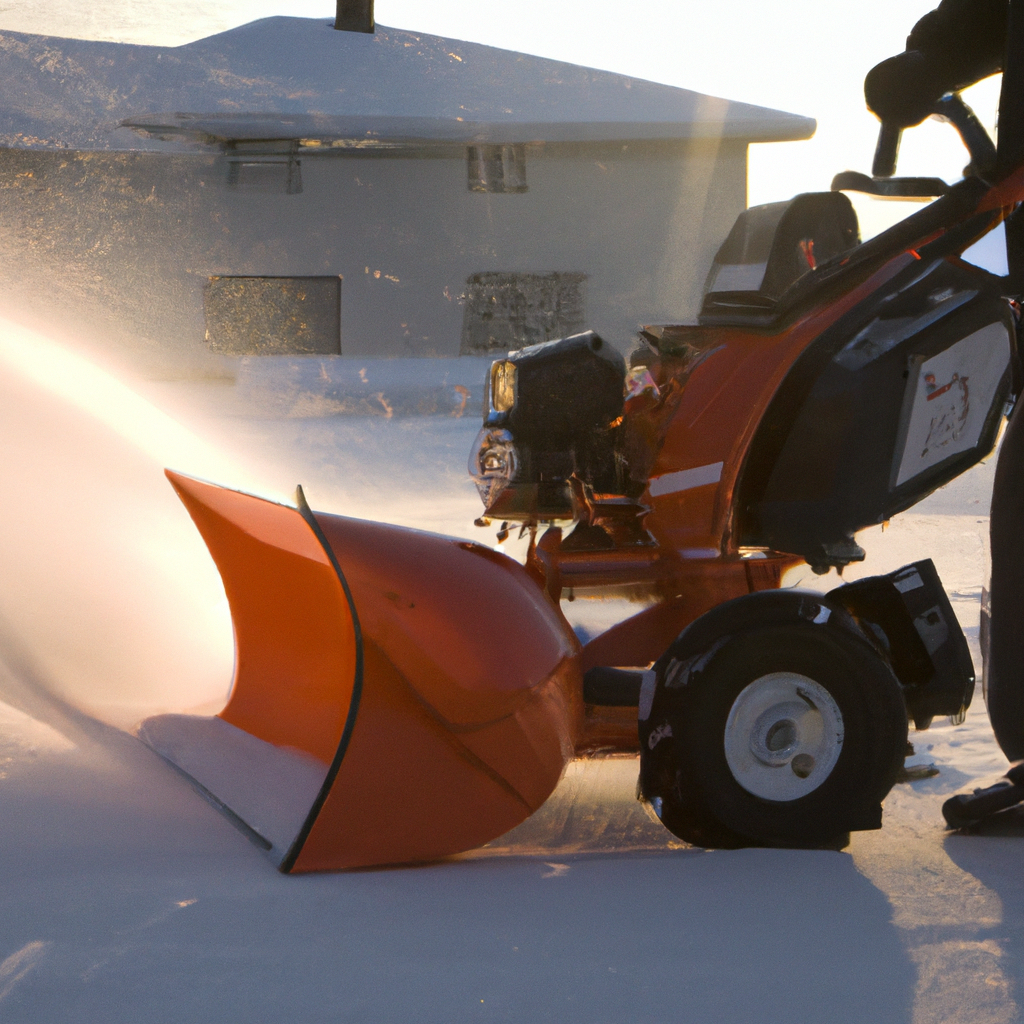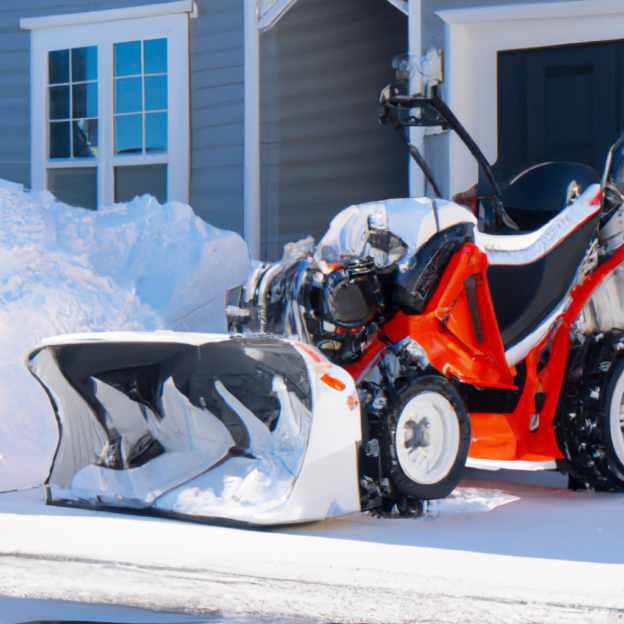When it comes to choosing the right snowblower for your needs, it can be overwhelming with all the options available. Whether you’re dealing with heavy snowfall or just a light dusting, finding the perfect snowblower can make all the difference in clearing your driveway and walkways efficiently. With factors like the size of your property, the type of snow you typically encounter, and your desired features, this article will guide you through the process of selecting the ideal snowblower for your specific requirements.
1. Consider Your Snowfall Amount and Type
When choosing the right snowblower for your needs, one of the first things you should consider is the average snowfall amount in your area. This will help you determine the size and power of the snowblower you’ll need. If you typically experience heavy snowfall, you’ll want to invest in a more powerful and robust snowblower that can handle large amounts of snow. On the other hand, if your area sees lighter snowfall, a smaller snowblower may be sufficient.
Another important factor to consider is the type of snow you typically encounter. Wet and heavy snow requires more power and a larger clearing mechanism compared to light and fluffy snow. Take note of the consistency of the snow in your area to ensure you choose a snowblower that can effectively handle the type of snow you’ll be dealing with.
Lastly, consider the size of your driveway. If you have a larger driveway, you’ll want to choose a snowblower with a wider clearing width to make the job quicker and more efficient. However, if you have a smaller driveway or limited storage space, a compact snowblower with a narrower clearing width may be more suitable.
2. Determine the Size and Power
Now that you have an understanding of the snowfall amount and type in your area, it’s time to determine the size and power of the snowblower that would best suit your needs.
2.1 Single-Stage Snowblowers
Single-stage snowblowers are generally smaller and more lightweight compared to two-stage and three-stage snowblowers. They are ideal for areas with light snowfall and relatively small driveways. They typically have a clearing width of around 18-22 inches and are powered by a single auger that not only throws the snow but also propels the machine forward.
2.2 Two-Stage Snowblowers
Two-stage snowblowers are more powerful and suitable for areas with heavier snowfall. They have an additional impeller that helps throw the snow further, allowing for faster and more efficient snow clearing. Two-stage snowblowers usually have a wider clearing width, ranging from 24-30 inches, making them perfect for larger driveways or commercial use.
2.3 Three-Stage Snowblowers
Three-stage snowblowers are the most powerful and robust option available. They are designed to handle heavy and wet snow with ease. In addition to the auger and impeller, they have an accelerator that breaks up the snow before it reaches the impeller, resulting in even better clearing performance. These snowblowers typically have a clearing width of 30 inches or more, making them suitable for large areas or deep snow accumulation.
2.4 Clearing Width
The clearing width of a snowblower refers to the width of the path it can clear in a single pass. A wider clearing width means you can clear a larger area with each pass, saving you time and effort. However, it’s essential to consider your specific needs and the size of your driveway or walkways. A wider clearing width may be more suitable for those with larger areas to clear, while a narrower clearing width may be sufficient for smaller spaces.
2.5 Engine Power
The engine power of a snowblower directly influences its performance. Higher engine power means the snowblower will be able to handle heavier snowfall and more challenging conditions. However, it’s important to strike a balance between power and fuel efficiency. Evaluate the engine power based on the snowfall amount and type you typically experience to ensure you choose a snowblower that can effectively handle the job without wasting excess fuel.

This image is property of pixabay.com.
3. Evaluate the Mobility Options
When it comes to snowblowers, mobility is a crucial factor to consider. Depending on your preference and physical capabilities, you can choose between self-propelled and push snowblowers.
3.1 Self-Propelled Snowblowers
Self-propelled snowblowers are equipped with a drive system that allows them to move forward without requiring much effort from the operator. This is especially beneficial when dealing with heavy snow or uneven terrain. Self-propelled snowblowers typically come with multiple speed settings, giving you greater control over the pace of clearing.
3.2 Push Snowblowers
Push snowblowers, as the name suggests, require manual pushing to move them forward. These snowblowers are generally more affordable and suitable for smaller areas with lighter snowfall. If you have a smaller driveway or are looking for a more budget-friendly option, a push snowblower may be the right choice for you. However, keep in mind that they require more physical effort to operate compared to self-propelled models.
4. Assess the Clearing Mechanism
The clearing mechanism of a snowblower refers to how it moves and throws snow. There are two main types of clearing mechanisms to consider: electric and gasoline-powered snowblowers.
4.1 Electric Snowblowers
Electric snowblowers are typically more lightweight and quieter than their gasoline counterparts. They are powered by an electric motor, making them environmentally friendly and easy to start. Electric snowblowers are ideal for smaller areas with light to moderate snowfall. Keep in mind that they may have limitations in terms of power and clearing capacity.
4.2 Gasoline Snowblowers
Gasoline snowblowers, also known as gas snowblowers, are more powerful and suited for heavy snowfall and larger areas. They are powered by an internal combustion engine, which provides the necessary power to handle challenging snow conditions. Gas snowblowers are generally more robust and capable of throwing snow at greater distances. However, they do require regular maintenance and can be noisier compared to electric snowblowers.

5. Consider the Start-Up Method
The start-up method of a snowblower refers to how it is started and ignited. There are two main start-up methods to consider: manual start and electric start.
5.1 Manual Start Snowblowers
Manual start snowblowers require the operator to pull a starter cord to ignite the engine. While this start-up method is reliable and doesn’t rely on external power sources, it can be more physically demanding, especially in cold weather conditions. If you have no issues with physical exertion and prefer a more traditional start-up method, a manual start snowblower may be suitable for you.
5.2 Electric Start Snowblowers
Electric start snowblowers feature a push-button start, similar to starting a car. This start-up method eliminates the need for manual pulling of a starter cord, making it easier and more convenient, especially for those with limited physical strength or dexterity. Electric start snowblowers typically require a power source, such as an electrical outlet or a rechargeable battery, to initiate the start-up process.
6. Think About Noise Levels
Noise levels may not be the first thing that comes to mind when choosing a snowblower, but they are worth considering, especially if you have close neighbors or live in an area with noise regulations.
6.1 Noise Regulations
Before purchasing a snowblower, familiarize yourself with any noise regulations or restrictions in your area. Some neighborhoods or municipalities may have specific rules regarding noise levels and operating hours for outdoor power equipment.
6.2 Noise Levels of Snowblowers
When comparing snowblowers, pay attention to their noise levels measured in decibels (dB). Electric snowblowers tend to be quieter compared to gasoline models. If noise is a concern for you, consider choosing a snowblower with lower noise levels to minimize disturbances and comply with regulations if applicable.

7. Look for Safety Features
Snowblowers, like any other machinery, come with inherent risks. It’s crucial to prioritize safety when selecting a snowblower. Here are some safety features to look out for:
7.1 Safety Interlock
A safety interlock is a feature that ensures the snowblower’s auger and impeller shut off when the operator releases the handle grip. This helps prevent accidents and injuries by immediately stopping the rotating components when the operator lets go.
7.2 Auger Housing
The auger housing should be well-built and sturdy to protect the operator from coming into contact with the rotating auger. Look for snowblowers with auger housings made of durable materials, such as reinforced steel or heavy-duty plastic.
7.3 Power Steering
Power steering is a valuable feature in larger and more powerful snowblower models. It makes maneuvering the machine easier by reducing the effort required to change direction while clearing snow. This feature can help prevent strain and fatigue, particularly when dealing with heavy snow.
7.4 Headlight
A headlight is a practical feature to have, especially if you tend to clear snow in low-light conditions or during early morning or evening hours. It provides enhanced visibility and ensures you can effectively see where you’re clearing, improving safety and preventing potential accidents.
8. Check the Warranty and Maintenance
When investing in a snowblower, it’s essential to check the warranty coverage and understand the maintenance requirements.
8.1 Warranty Coverage
Carefully read the warranty information provided by the manufacturer to understand what is covered and for how long. A longer warranty period can provide peace of mind and protection against manufacturing defects or malfunctions. Ensure you follow recommended maintenance practices to avoid voiding the warranty.
8.2 Maintenance Requirements
Regular maintenance plays a vital role in keeping your snowblower in optimal working condition. This typically includes tasks such as oil changes, spark plug replacements, and proper storage during off-seasons. Consider the maintenance requirements of the snowblower you are interested in to ensure you can adequately fulfill them or seek professional assistance if needed.
9. Consider Budget and Price Range
Budget considerations are often an essential aspect when choosing a snowblower. Determine the amount you are willing to spend and consider the following factors:
9.1 Budget Considerations
Evaluate the long-term cost of ownership, including maintenance, fuel, and potential repairs. While cheaper options may be appealing initially, they may incur higher operating costs or have a shorter lifespan. It’s crucial to find the right balance between affordability and quality.
9.2 Price Range
Snowblower prices vary based on factors such as size, power, and features. It’s recommended to compare prices from different manufacturers and retailers to find the best deal within your budget. Remember to prioritize quality and suitability for your specific needs over price alone.
10. Read Reviews and Seek Recommendations
Before making a final decision, take the time to read online reviews and seek recommendations from friends, family, or neighbors who may have experience with snowblowers. Reviews and recommendations can provide valuable insights into the performance, durability, and user satisfaction of different snowblower models. Consider both positive and negative feedback to make an informed decision that best suits your needs.
Choosing the right snowblower for your needs requires careful consideration of several factors. Assess your average snowfall amount, the type of snow you typically encounter, and the size of your driveway. Determine the size and power of the snowblower based on these factors, and consider the mobility options that best fit your preferences. Assess the clearing mechanism, start-up method, noise levels, safety features, warranty coverage, and maintenance requirements. Finally, consider your budget and price range, and consult reviews and recommendations before making a final decision. By following these guidelines, you’ll be well-equipped to choose the right snowblower that will make clearing snow a breeze. Stay warm and safe during those winter months!
